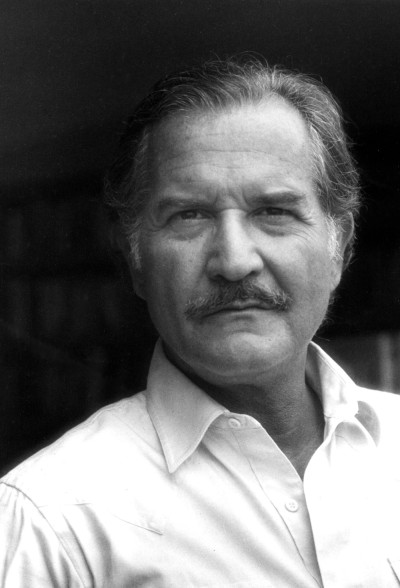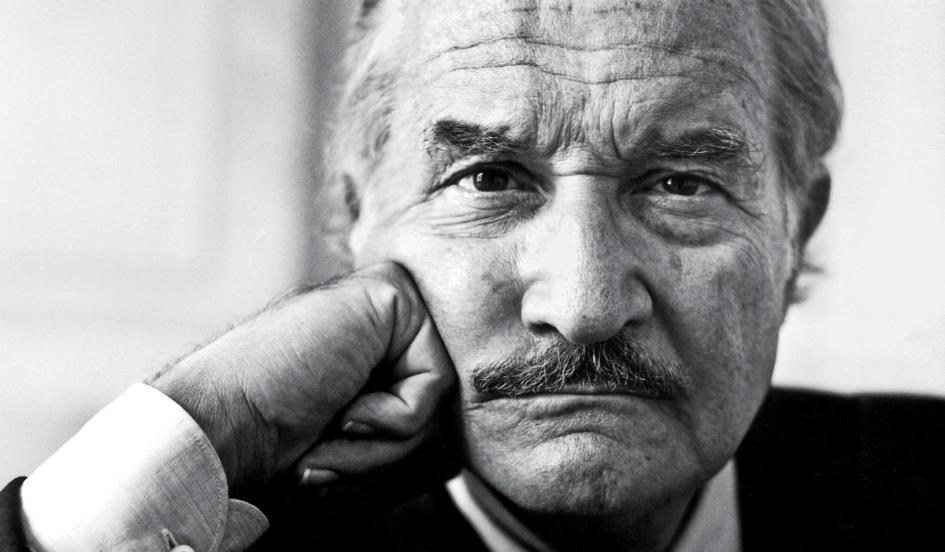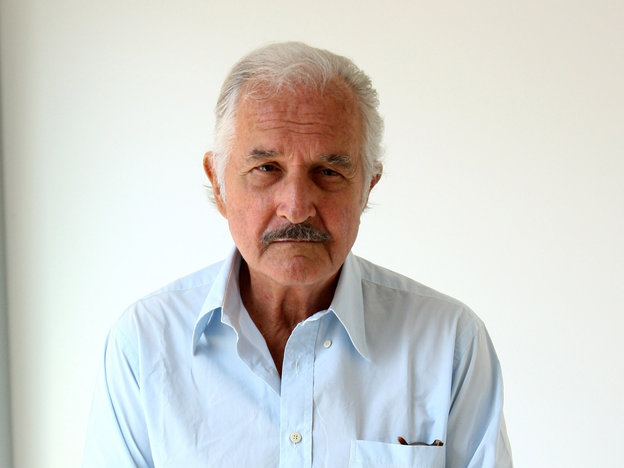Carlos Fuentes (Carlos Fuentes)

Fuentes was born in Panama City to Berta Macías and Rafael Fuentes, the latter of whom was a Mexican diplomat. As the family moved for his father’s career, Fuentes spent his childhood in various Latin American capital cities, an experience he later described as giving him the ability to view Latin America as a critical outsider. From 1934 to 1940, Fuentes’ father was posted to the Mexican Embassy in Washington, D.C., where Carlos attended English-language school, eventually becoming fluent. He also began to write during this time, creating his own magazine, which he shared with apartments on his block.
In 1938, Mexico nationalized foreign oil holdings, leading to a national outcry in the U.S. and Fuentes’ ostracism by his American classmates; he later pointed to the event as the moment in which he began to understand himself as Mexican. In 1940, the Fuentes family was transferred to Santiago, Chile. There Carlos first became interested in socialism, which would become one of his lifelong passions, in part through his interest in the poetry of Pablo Neruda. He lived in Mexico for the first time at the age of 16, when he went to study law at the National Autonomous University of Mexico (UNAM) in Mexico City with an eye toward a diplomatic career. During this time, he also began working at the daily newspaper Hoy and writing short stories.
In 1957, Fuentes was named head of cultural relations at the Secretariat of Foreign Affairs. The following year, he published Where the Air Is Clear, which immediately made him a “national celebrity” and allowed him to leave his diplomatic post to write full-time. In 1959, he moved to Havana in the wake of the Cuban Revolution, where he wrote pro-Castro articles and essays. The same year, he married Mexican actress Rita Macedo. Considered “dashingly handsome”, Fuentes also had high profile affairs with actresses Jeanne Moreau and Jean Seberg, the latter of whom inspired his novel Diana: The Goddess Who Hunts Alone. His second marriage, to journalist Silvia Lemus, lasted until his death.
Fuentes served as Mexico’s ambassador to France from 1975 to 1977, resigning in protest of former President Gustavo Díaz Ordaz’s appointment as ambassador to Spain. He also taught at Cambridge, Brown, Princeton, Harvard, Columbia, University of Pennsylvania, Dartmouth, and Cornell. His friends included Luis Buñuel, William Styron, Friedrich Dürrenmatt, and sociologist C. Wright Mills, to whom he dedicated his book The Death of Artemio Cruz. Once good friends with Nobel-winning Mexican poet Octavio Paz, Fuentes became estranged from him in the 1980s in a disagreement over the Sandinistas, whom Fuentes supported. In 1988, Paz’s magazine Vuelta carried an attack by Enrique Krauze on the legitimacy of Fuentes’ Mexican identity, opening a feud between Paz and Fuentes that lasted until Paz’s 1998 death. In 1989, he was the subject of a full-length PBS television documentary, “Crossing Borders: The Journey of Carlos Fuentes,” which also aired in Europe and was broadcast repeatedly in Mexico.
Fuentes fathered three children. Only one of them survived him: Cecilia Fuentes Macedo, born in 1962. A son, Carlos Fuentes Lemus, died from complications associated with hemophilia in 1999 at the age of 25. A daughter, Natasha Fuentes Lemus (born August 31, 1974), died of an apparent drug overdose in Mexico City on August 22, 2005, at the age of 30. Fuentes described himself as a pre-modern writer, using only pens, ink and paper. He asked, “Do words need anything else?” Fuentes said that he detested those authors who from the beginning claim to have a recipe for success. In a speech on his writing process, he related that when he began the writing process, he began by asking, “Who am I writing for?”
Fuentes’ first novel, Where the Air Is Clear (La región más transparente), was an immediate success. The novel is built around the story of Federico Robles – who has abandoned his revolutionary ideals to become a powerful financier – but also offers “a kaleidoscopic presentation” of vignettes of Mexico City, making it as much a “biography of the city” as of an individual man. The novel was celebrated not only for its prose, which made heavy use of interior monologue and explorations of the subconscious, but also for its “stark portrait of inequality and moral corruption in modern Mexico”.
A year later, he followed with another novel, The Good Conscience (Las Buenas Conciencias), which depicted the privileged middle classes of a medium-sized town, probably modeled on Guanajuato. Described by a contemporary reviewer as “the classic Marxist novel”, it tells the story of a privileged young man whose impulses toward social equality are suffocated by his family’s materialism.
Fuentes’ best-known novel, The Death of Artemio Cruz (La muerte de Artemio Cruz) appeared in 1962 and is today “widely regarded as a seminal work of modern Spanish American literature”. Like many of his works, the novel used rotating narrators, a technique critic Karen Hardy described as demonstrating “the complexities of a human or national personality”. The novel is heavily influenced by Orson Welles’ Citizen Kane, and attempts literary parallels to Welles’ techniques, including close-up, cross-cutting, deep focus, and flashback. Like Kane, the novel begins with the titular protagonist on his deathbed; the story of Cruz’s life is then filled in by flashbacks as the novel moves between past and present. Cruz is a former soldier of the Mexican Revolution who has become wealthy and powerful through “violence, blackmail, bribery, and brutal exploitation of the workers”. The novel explores the corrupting effects of power and criticizes the distortion of the revolutionaries’ original aims through “class domination, Americanization, financial corruption, and failure of land reform”.
Fuentes’ 1975 Terra Nostra, perhaps his most ambitious novel, is a “massive, Byzantine work” that tells the story of all Hispanic civilization. Modeled on James Joyce’s Finnegans Wake, Terra Nostra shifts unpredictably between the sixteenth century and the twentieth, seeking the roots of contemporary Latin American society in the struggle between the conquistadors and indigenous Americans. Like Artemio Cruz, the novel also draws heavily on cinematic techniques. The novel won the Xavier Villaurrutia Award in 1976 and the Venezuelan Rómulo Gallegos Prize in 1977.
His 1985 novel The Old Gringo (Gringo viejo), loosely based on American author Ambrose Bierce’s disappearance during the Mexican Revolution, became the first U.S. bestseller written by a Mexican author. The novel tells the story of Harriet Winslow, a young American woman who travels to Mexico, and finds herself in the company of an aging American journalist (called only “the old gringo”) and Tomás Arroyo, a revolutionary general. Like many of Fuentes’ works, it explores the way in which revolutionary ideals become corrupted, as Arroyo chooses to pursue the deed to an estate where he once worked as a servant rather than follow the goals of the revolution. In 1989, the novel was adapted into the U.S. film Old Gringo starring Gregory Peck, Jane Fonda, and Jimmy Smits. A long profile of Fuentes in the U.S. magazine, “Mother Jones,” describes the filming of “The Old Gringo” in Mexico with Fuentes on the set.
On May 15, 2012, Fuentes died in Angeles del Pedregal hospital in southern Mexico City from a massive hemorrhage. He had been brought there after his doctor had found him collapsed in his Mexico City home. Mexican President Felipe Calderón wrote on Twitter, “I am profoundly sorry for the death of our loved and admired Carlos Fuentes, writer and universal Mexican. Rest in peace.” Nobel laureate Mario Vargas Llosa stated, “with him, we lose a writer whose work and whose presence left a deep imprint”. French President François Hollande called Fuentes “a great friend of our country” and stated that Fuentes had “defended with ardour a simple and dignified idea of humanity”. Salman Rushdie tweeted “RIP Carlos my friend”. Fuentes received a state funeral on May 16, with his funeral cortege briefly stopping traffic in Mexico City. The ceremony was held in the Palacio de Bellas Artes and was attended by President Calderón.
Mexican historian Enrique Krauze was a vigorous critic of Fuentes and his fiction, dubbing him a “guerrilla dandy” in a 1988 article for the perceived gap between his Marxist politics and his personal lifestyle. Krauze accused Fuentes of selling out to the PRI government and being “out of touch with Mexico”, exaggerating its people to appeal to foreign audiences: “There is the suspicion in Mexico that Fuentes merely uses Mexico as a theme, distorting it for a North American public, claiming credentials that he does not have.” The essay, published in Octavio Paz’s magazine Vuelta, began a feud between Paz and Fuentes that lasted until Paz’s death. Following Fuentes’ death, however, Krauze described him to reporters as “one of the most brilliant writers of the 20th Century”. Fuentes’ works have been translated into 24 languages. He remained prolific to the end of his life, with an essay on the new government of France appearing in Reforma newspaper on the day of his death.
Born
- November, 11, 1928
- Panama City, Panama
Died
- May, 15, 2012
- Mexico City, Mexico
Cemetery
- Cimetière de Montparnasse
- Paris, France



